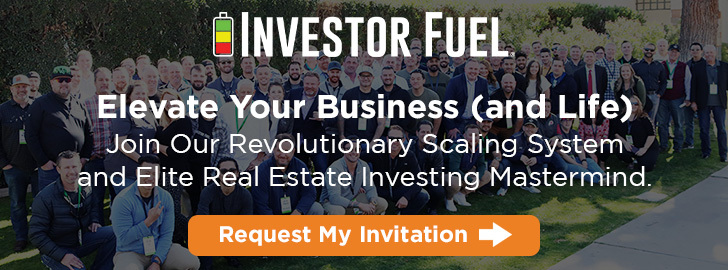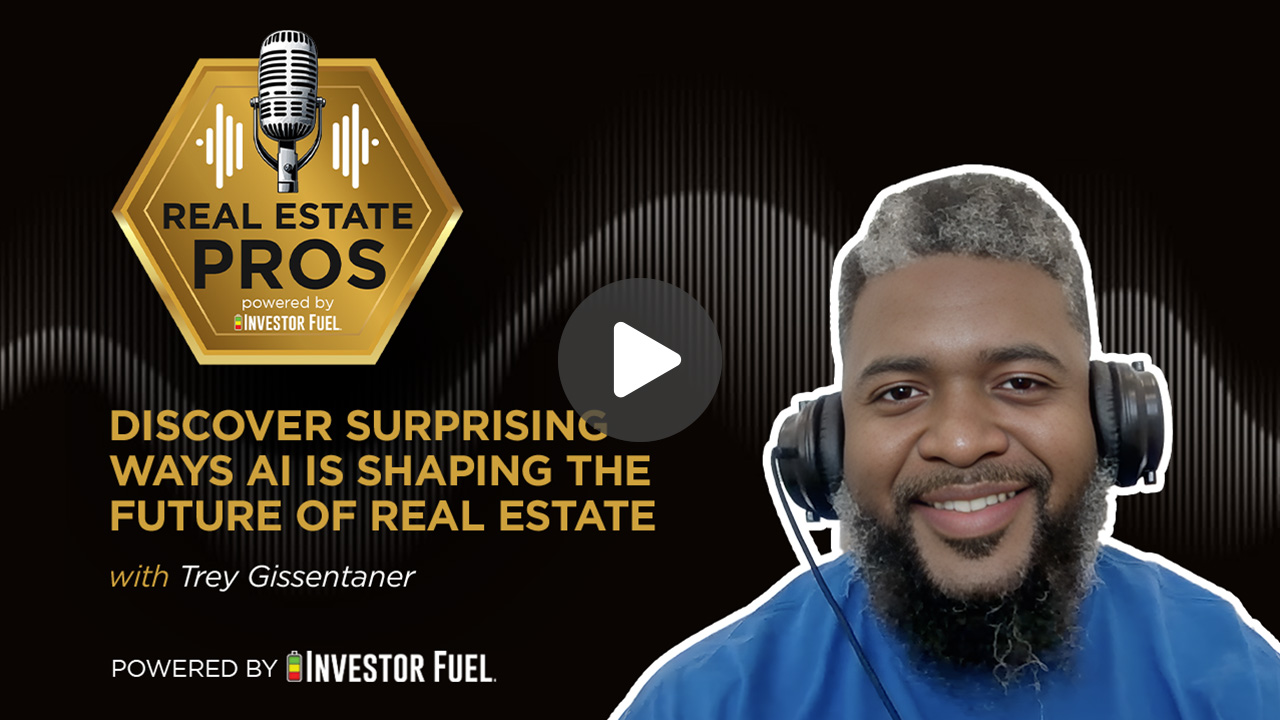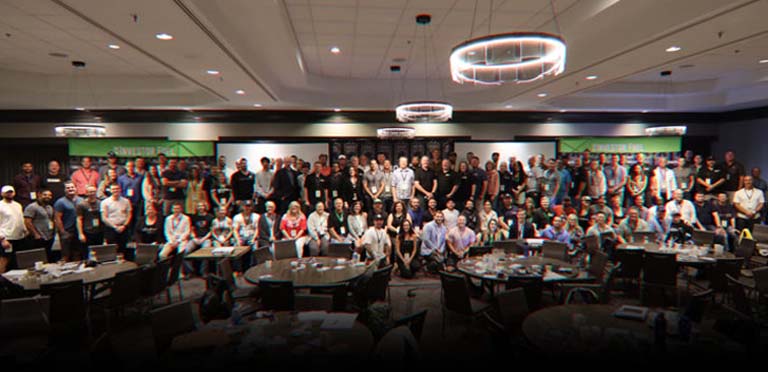
Show Summary
In this episode, Stephen Schmidt interviews Trey Gissentaner, a former structural engineer turned real estate entrepreneur. Trey shares his journey from wholesaling to founding Pickleeds, a company that leverages AI to identify undervalued properties. He discusses the challenges he faced in the early days of his career, the innovative solutions he developed, and his vision for the future of real estate technology. The conversation highlights the importance of adaptability in the real estate market and the potential for technology to transform the industry.
Resources and Links from this show:
Listen to the Audio Version of this Episode
Investor Fuel Show Transcript:
Stephen Schmidt (00:03.17)
Welcome to the show where we interview the nation’s leading real estate entrepreneurs It’s your host Stephen Schmidt and I’m back at it like a bad habit if you’re joining us for the second third or hundredth time Welcome back to the show if you’re joining us for the first time Where you been at? This is about to become a regular on your listening dock in a podcast and we’re grateful that you’re here I got a really cool treat for you guys here today I got Trey Gissentaner in the house and Trey has been in the real estate space for over
eight years now. actually originally started in the wholesaling portion of real estate as many of us and many of you are in or have been in to get your first feet in. He’s actually got a pretty cool background where before he did that he was a structural engineer and now he also is the founder of Pickleeds which we’re going to talk a little bit about today and how he’s disrupting the industry and the wholesaling space.
So we’re gonna get right into it, but before we do that, just remember here at Investor Fuel, we help real estate investors, service providers, and real estate entrepreneurs, two to five X their businesses, so they can build the businesses they’ve always wanted in order to live the lives they’ve always dreamed of. With that being said, Trey, welcome to the show.
Trey Gissentaner (01:15.352)
Hey, thanks so much Stephen. Thanks for having me. Yes sir.
Stephen Schmidt (01:18.848)
And for any of you listening just on the audio and not on the YouTube, Trey also wears his headphones in the coolest way I’ve ever seen because he’s got perfect hair. That headphone wear is exactly what I have to do. Normally I wear a cowboy hat, but it’s been a little hot lately and I need to get a new straw hat. I only have a felt one on me right now, but the headphones don’t exactly fit over the brim of the hat. That’s how I would wear up to.
Trey Gissentaner (01:38.18)
Man.
It’s so hot here in Texas man, I’m telling you I gotta keep the kids inside but thanks for having me man
Stephen Schmidt (01:49.154)
Yeah, likewise. Glad to have you here, Where in Texas are you at? I guess we missed that in the pre-show conversation.
Trey Gissentaner (01:55.522)
Yeah, yeah, so I’m actually up here in the DFW just north of McKinney and a very very rapidly growing suburb called Melissa, Texas so Melissa We got a chibi got Kroger. We got Walmart. It’s not like a little country town no more so mr
Stephen Schmidt (02:05.751)
No kidding.
Stephen Schmidt (02:12.214)
You bet, that’s awesome. I didn’t realize you were in our backyard here. That’s super cool. We’re out of Dallas, Fort Worth.
Trey Gissentaner (02:16.11)
Where I am. yeah, there we go. Awesome.
Stephen Schmidt (02:20.75)
Well, well, Trey, let me ask you this. You were a structural engineer, turned real estate investor, flipped a couple hundred properties and in the wholesale space, started Pickleeds. How’d you get into the business for one? And then how did things evolve to where you’re at now today?
Trey Gissentaner (02:25.262)
Yes, sir.
Trey Gissentaner (02:28.937)
Mm-hmm. Mm-hmm. Mm-hmm.
Yeah.
Trey Gissentaner (02:40.64)
Yeah, so my story kind of starts off like this. I wanted to be the best structural engineer I could be. And so I actually made the jump from Florida, South Florida. And then I actually came over to the Bay Area, California, because I wanted to do seismic design. And so was driving down the highway with my boss at the time. And he asked me, hey, Trey, what’s your reason for kind of coming out here in California? You know, just give me the real. said, I want to become principal structural engineer. He said, you’ll never become that here.
to me people ain’t ahead of you and I took that and I said okay so long story short I was only at that job for maybe three months and then I had a talk with my wife I said I said babe do you believe him after moving I mean after it was only three months and he said you you will never become that here but that doesn’t mean that you won’t become a really good engineer you know so anyway you know I remember like it was yesterday
Stephen Schmidt (03:22.088)
After moving from Florida to California, by the way.
Trey Gissentaner (03:40.406)
I said baby believe in me she said yes, and I quit my job I’m a two weeks in and we had to survive in Northern California till I got my first deal and
It was just on the ground making phone calls and text messages. And this is before all the regulations guys. I mean it was just like whatever it took to get a deal. That’s what I did. I was arbitrage and FizzBowls every day. I actually came up with a system and in my first deal happened and I closed it three months after I quit my job. It was a forty thousand dollars spread that I was able to keep twelve grand of.
Because it was like three other people a part of it guys have to share money in the beginning because you don’t have a buyer I’ve been there and It hey, I took that 12 grand move to Texas and rest was history
Stephen Schmidt (04:38.018)
No kidding. So you moved to Texas, you got that first deal under your belt, then you moved to Texas, and what happened when you got to Texas?
Trey Gissentaner (04:44.516)
Hmm.
Trey Gissentaner (04:48.004)
Yeah, so first year was tough, right? First year was tough. I mean, I had to figure out what I was doing. But then I finally did maybe five deals. I could afford to actually, and I was actually down in the Rio Grande Valley, down in Brownsville, of all places, right? And just kind of figured it out down there. I was doing virtual deals. And then what happened was, I got hooked up with several hedge funds. And that was the one that kind of changed my life there because when I started to figure it out, they were buying 80,
90 cents on the dollar I was just able to replicate right so at the time we had Twilio Zapier text messages and we used to blast 10,000 a day and we were locking up probably five to seven deals a month and so that kind of changed the game there and you know we start seeing those numbers and that revenue kind of happened you know you’re like wow you know so but
Stephen Schmidt (05:45.07)
Where was this the whole time? Yeah.
Trey Gissentaner (05:47.0)
Yeah, what was this the whole time right? But you know I’ll tell you one of the best deals I did and it was a tough one, but I did one in Midland, Texas out in oil country and I got it for a five sold it for a hundred thousand and I mean Builder went in there turned around for 275 right? So, you know, I met a lot of cool people along the way but at the foundation of it was always ugly house, right? And so that was kind of always the telltale sign of
Hey, know, ugly house is the way to go. And that really kind of took form here in the next few years when the hedge funds stopped buying so close, right? So you have to kind of adapt back to old school practices.
Stephen Schmidt (06:34.156)
totally make sense. Now so you were crushing it and then you decided to start pick leads. How did that happen?
Trey Gissentaner (06:42.276)
Yeah. So what happened with Pickleys is just that I began to do more and more mentoring. I actually started doing more and more data aggregation because
You know, hey, my expertise kind of spoke for itself and I had a client over in Pittsburgh, Pennsylvania. Now, Pittsburgh is not the hardest place in the world for you to actually get deals, but there’s certain areas there that even it’s the old town. It’s kind of unique to know where all the ugly houses are at. So I have a really good friend. His name is Micah and he’s actually my partner on Pickle Eats. Hey, Micah, if you can hear this. And we just had this idea and we used to drive by houses.
And just verify okay, this is the one in Shady side that was ugly And so we would actually do like a lot of driving for dollars to kind of verify kind of what we were looking at and say okay How can we really automate this well it turned into a situation? We’re like the middle part of last year We kind of really figured out that we could trained AI brains to actually Return that pretty accurate information that we saw ourselves in real time and when we saw that honestly
the Google image dates and the conditions of those didn’t really change over the past like maybe shoot five years. We knew we had something and so that’s when we started really trying to converge well on all of the under like all of our the factors like the roof deciding the windows and all that kind of stuff and then we were able to score them. So that’s it was undertaking and it was a lot of like going back and forth.
but we finally got it to the point where it’s presentable and it works.
Stephen Schmidt (08:28.258)
Now, so how exactly does it work?
Trey Gissentaner (08:30.628)
Yeah, yeah. So the way Picklease works is what we do is we say, hey, we pull on the Google APIs, right? And based upon the API of the roof, we capture the roof. We can actually capture solar too. So Picklease is more than just a real estate tool. It’s also a service industry tool as well. And what we do is we say, okay, what
If you had to describe so when you’re teaching AI you always have to say if you had to describe this Right. What what are the key features that you see and based upon those buzzwords that AI would kid back to us We were able to take those words and then score it appropriately, right? So we went from You know, so the key to keep your costs down is not necessarily asking it the longest drawn-out question
questions to confuse it, but more so say, so for each, so we started off with maybe like one long prompt that we realized we need to have several questions for each.
Stephen Schmidt (09:44.91)
portion.
Trey Gissentaner (09:45.088)
facet right so that’s how we were able to teach it so Hey AI what’s the if we had to if we said hey Hey GPT what is the condition of the roof is like well I don’t know it looks like it needs wear and tear XYZ but if we say Hey GPT based upon which you can see on Google Maps what type of roof is this okay like if you’re out in Vegas it’s terracotta
Okay, do you see any standing on terra cotta roof? You know, so you have to train it appropriately in order for it to give back what you need or again, you Not do what it’s supposed to do
Stephen Schmidt (10:30.52)
Yeah, because ultimately it’s only as good as how you train it. Man, that’s so good. So, go ahead.
Trey Gissentaner (10:34.614)
Exactly. That’s right. That’s right. So So yeah
Yeah, so that’s what we did and we realized is we have several factors there. have roof, siding, windows. We had gutters, but we kind of omitted that. The biggest one that we include is landscaping. So we score everything out of 10 on a scale of one to 10. And the biggest factors that we actually look at is landscaping and overall curb appeal.
See curb appeal, what we do with curb appeal is we look and we say, can we actually see the property from facing it? So sometimes you have big oak trees in the front yard. Sometimes you have different materials and all that kind of stuff happening in that Google image. Well, if the property has good curb appeal, right? Then if it’s weighted, which it is, we waited to say, okay, this person,
has a decent property. But if there’s different things that we have to do to the yard, because you can spend 10 grand in the yard alone, right? If we can see a dumpster in the yard, if we can see this in the yard, we say, okay, curb appeal is like a one or a two or something like that, right? Even though the actual property itself is maybe a four, right? Or five. So the cool thing about Picklees is that it allows you to get your list scanned and then take a list of 20,000
properties and only focus on the 2,000 ugly ones that you really want to focus on. So what is this going to do for your marketing budget? It’s going to make you highly targeted all while be it you’re saving money and we made this for the new wholesaler. We made it for the guys who knew we knew they only had maybe a thousand or two thousand dollars entering to the game right and we say hey we know you’re going to do direct marketing we understand that well guess what?
Trey Gissentaner (12:40.102)
When you check hey absentee owner when you check
Vacant properties. Do you know how saturated these lists are very saturated? But I kid you not we have properties here that we’ve looked at on pick leads and these show owner-occupied What does that mean? Just means somebody’s collecting the mill doesn’t mean that somebody really cares, right? And so that’s The niche that we are going after We’re going after high value ugly houses That will not show up on your typical
list on the data aggregate sites.
Stephen Schmidt (13:21.326)
What a great, what a great tool. Now, what do you see this turning into in the next, say, 18 to 24 months?
Trey Gissentaner (13:31.832)
Hehehehe
So if I had to speak on this is I mean we’re we’re in talks right now of getting wet and again white label But but here’s the thing right that’s just for the the virtual driving for dollars technology, The what we have beyond this is the underwriting tool.
The underwriter is the baby that I am taking care of because what we did was we actually brought out the camera a bit to be able to capture the neighborhood. So we captured the houses right next door and then we flipped the camera around to capture what’s across the street. So here’s the thing, right? If you’re doing virtual wholesaling, right? And you, and we’re looking, we’re working to automate this, but of course more images, more APIs, more costs, right?
doing a deal in making Georgia. Now some of us who have done deals in making Georgia knows everything’s ugly in making Georgia. If you are watching this from making Georgia, trust me, I love you, but there are some spots. I’m from Cleveland, Ohio, so trust me, I know there’s some ugly spots in Cleveland, Ohio. But what’s so important is when you pull that list, we want to be able to automate the neighborhood as well. We already have household median income integrated, which most people don’t have in their data sets.
Well guess what? The lower the household median income and then when we turn the camera around, if it looks ugly across the street, is that really an area that an investor’s really gonna wanna flip a property in? Or is that gonna be a hindrance because they’re gonna be afraid that somebody’s gonna break in and take all of their materials while they’re mid flip, right? Or is this even in a location that, is ARV really there, right? There’s still 10, $15,000 houses here in America
Trey Gissentaner (15:25.574)
because if you want to call it an ARV, it’s just retailing for maybe 80 to $100,000. So as a wholesaler, you don’t want to be in locations where it’s tough for the bank to issue a loan, right? Because your end-end buyer is going to be that, hey, Brad, Nancy, two kids and the dog, right? And they’re going to be wanting to live in nicer neighborhoods. So then you’re able to kind of understand, OK, is this really an opportunity for me? And that’s why I always tell my inbound guys, I say,
Hey guys, we got you. We understand that you guys are doing big-time volume Take a look at our underwriting tool so that you guys can have an understanding of what the neighborhood is at a glance household median income right and just know if this is an opportunity that you really want to put a contract on because The tough part about the business is just that sometimes we have to say no and so this tool is going to help you To do that at a glance right by also providing you
rehab costs, right? And then not just rehab costs, but you know, it also built in if you want to make a 10,000 on the wholesale spread. So those are the things that we’re working on. We also have a pick value as well. So the pick value is what we actually came up with as actually are what it actually should go for on the market. Let’s just say it retails for 175, but the pick value is 120. It’s because if you listed it for 120, it probably would get down on the market because of the condition that we can see from the X.
So that’s what we’ve done with our under rider. So you asked me what the next maturation is, it’s that.
Stephen Schmidt (17:02.318)
And then a billion dollar exit. What?
Trey Gissentaner (17:05.731)
We’re working extremely hard. We’re coming for Zillow. Hey guys, we love you over at Zillow, but your evaluations are off sometimes.
Stephen Schmidt (17:10.903)
Hahaha
Stephen Schmidt (17:16.75)
Man, so what gets you really excited about this business?
Trey Gissentaner (17:21.956)
What gets me excited about it is changing lives, right? Like my life was changed, right? Like, and, and I can’t tell you how many people’s lives have been changed just from, you know, me sitting down, talking to them, encouraging them. You know, I I had a guy, I was out living out in Las Vegas at the time. And, cause we made a pivot to Vegas too, for a couple of years. And he came out and he met with me and never done a double close. And I said, you got to start double closing your deals. Right? Like this is all a journey.
for all of us. And then kids, you’re not. Two months later, he did the $97,000 double close. That’s the beauty of this is just knowing how to navigate and then adding value to everyone. And so what I’m excited about right now is just that in the next, like you said, the next 18 to 24 months, we hope to have the entire country captured. We hope to have the databases captured so that now we’re able to include comp data.
Because we aggregate several ABM’s I’ll be honest with you, but we want to bring in to the best of our ability like we’re here in Texas Where it’s a non-disclosure state? We want to get access to MLSs. We want to partner with more real estate agents We want this to become a household tool or real estate investors and professionals and agents are like, okay This is really what I’m getting myself into right? So we want to capture as much
data as possible and link it to what it looks like because we believe that when we do that, I mean, we can begin to automate real estate. You’ve already seen these bots who are able to integrate or they’re able to talk to people and it sounds like a real person. Well, we believe that the missing link is what is the house? And if we can find out what the house is, we can solve a lot of problems.
Stephen Schmidt (19:16.312)
You’re one of those people replacing us with robots, Trey. Just kidding.
Trey Gissentaner (19:20.76)
Hey, hey, hey, listen, hey, listen. We gotta make sure that we’re adding value and that we’re making money at the end of the day, right? So, yes sir. Hey, man.
Stephen Schmidt (19:31.237)
I’m just joking with you. Trey, where can these people go connect with you for more, learn more about what you’re working on, stay connected? What’s the best place to do that?
Trey Gissentaner (19:40.578)
Yes, I the best place for you to do that is actually Facebook of all places. I have a group there. You know, look me up trade. Yes. And Tanner, I have a little small following on Tik Tok as well. Tracy speaks. And of course, go to pick leads dot com and check out pick leads.
Stephen Schmidt (19:57.954)
Bada boom bada bing go get you some pick leads. You know what I’m saying? All right folks Well, we appreciate you tuning into today’s episode Trey Thanks so much for coming on and I’m sure you’re gonna probably have some folks using you after this show So we’ll have to have how we’ll have to have our special code something something real estate pros That way, you know, they came from us
Trey Gissentaner (20:15.229)
Amen. We’ll do it. We’ll do it. We’ll make it happen. Thanks.
Stephen Schmidt (20:20.002)
Alrighty folks, have a great rest of your day and thanks again for listening. Thanks again, Trey.
Trey Gissentaner (20:24.516)
All right.






